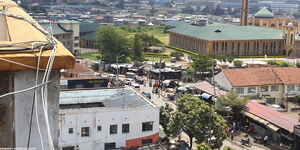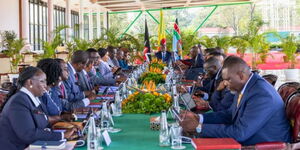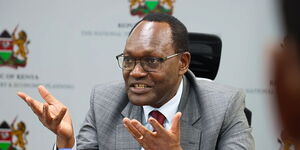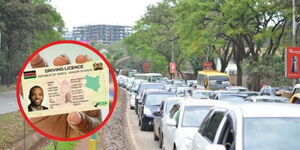In a heated session marked by frank exchanges and pressing concerns, President William Ruto faced a barrage of tough questions from university student leaders about the new university funding model, which has stirred unrest.
Gichangi Gitonga, the Secretary-General of Jomo Kenyatta University of Agriculture and Technology (JKUAT), set the tone with a candid disclosure of the pressures he faced from his constituents.
"The entire time I was sitting on this seat, it was getting hotter and hotter," said Gitonga.
He questioned the haste in implementing a model riddled with complexities and accused the administration of using student leaders as "rubber stamps" in policy decisions.
Highlighting concerns about transparency and corruption, Gitonga challenged President Ruto to address the discrepancies in financial figures related to higher education debts, which have varied in public statements.
"We were told of a debt of Ksh70 billion at HELB, then Ksh51 billion for private universities, and today you mention Ksh180 billion. As a financial engineer, I find it hard to reconcile these figures," he stated.
Kennedy Otieno, Secretary-General of Kenya Methodist University, echoed the sentiment criticising the model for not reducing the financial burden on families.
"The fee has not fallen, that is why we are here," Otieno argued, questioning the need to overhaul the previous model instead of improving it.
Students proposed eliminating problematic financial bands and consolidating funds to reduce tuition costs effectively.
In his defence, President Ruto provided a historical perspective on the funding structure, asserting that the concept of banding was not novel but rather an extension of a policy initiated in 1996.
"The new model has 5 bands, and all we did was expand from 4 bands to 5," Ruto explained, stressing continuity in policy evolution.
Ruto also drew on his personal experiences to underscore the long-standing nature of the student loan system.
"I went to university in 1987 with a loan of 55,000 at an interest of 2%, which I repaid when I started working. The loan component has always been there; it is what makes the model sustainable," he explained.
Addressing the broader implications of education on national integrity, Ruto warned, "To destroy a nation, you don't need an atomic bomb or long-range missiles. Lowering the quality of education and allowing exam cheating can destroy a nation."
He explained his commitment to reform by referencing the appointment of a 42-person task force tasked with resolving issues in the education sector.
Concluding, President Ruto acknowledged the imperfections in the current model but expressed confidence in its direction.
"We are not saying the model is perfect, but I believe it is 95% in the right direction, and we will continue to improve on it," he reassured.
The new funding model has left parents and their children in uncertain situations even as students prepare to join institutions of higher education at different levels.












